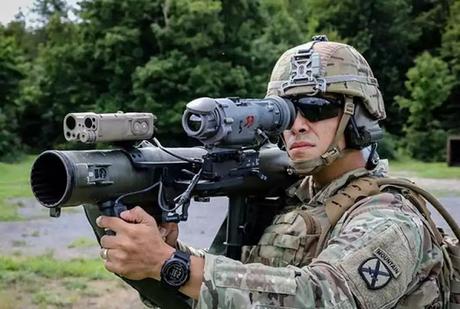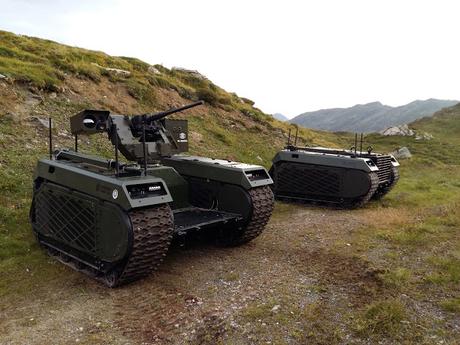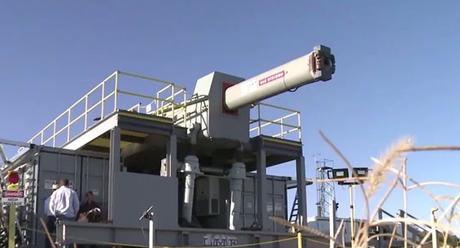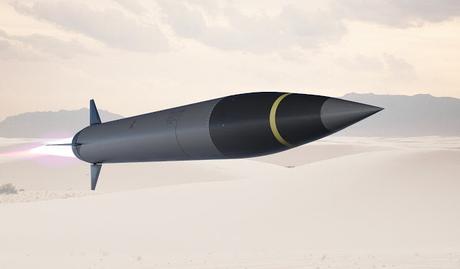
Photo Credit: Google Images
Almost 800 military bases around the globe. Close to 70,000 troops in the Middle East. 14,000 soldiers in Afghanistan alone. There might not be a major war going on with the US, but make no mistake, its military is busy.
That’s why the Department of Defense's budget for 2020 is a whopping $721.5 billion, and a good chunk of that cash goes towards the new weapons that troops are using this year. As you’ll find out today, some of those weapons people wouldn’t have dreamed of two decades ago.
They are dangerous, they are smart, they were cooked up by the best scientific minds the US has to offer. But let’s also not forget about China, a country, you will see, that may have a new weapon to send us back to the dark age.
10. A smarter kind of body armor

The Integrated Head Protection System (IHPS) is the latest combat helmet and it would be an understatement to say helmets have come a long way since the M1 helmet, the kind you might have seen in the Vietnam War. Those things wouldn’t have been much help if a soldier took a hit in the face, but the IHPS comes with what’s called maxillofacial protection.
That means it protects a large part of the face, much like a full motorcycle helmet. Is that useful? Well, ask the soldier whose life it recently saved in Afghanistan. The soldier was glad he was wearing it when he got hit in the face by an object thrown by an angry mob.
That was in 2019, but word on the street is the helmets are now out of testing and are being deployed in masse. The IHPS not only protects the eyes and the face, but it’s 5 percent lighter than helmets that were used before it. It’s stronger, too, giving more protection from blunt force trauma. If you add to it the “applique armor”, which is just add-ons, it stands a good chance of saving a soldier’s head from bullets and flying debris.
As for more add-ons, it has side rails so things such as flashlights can be added. The army has said it’s never had a helmet like this before, so let’s hope it saves some people’s lives. Don’t worry, we’ll get to the killer weapons soon.
9. Night vision from the future

The army has just been given the Enhanced Night Vision Goggle-Binocular to test. So far only the 2nd Brigade Combat Team of the 1st Infantry Division has used them, but we expect they will become widely available soon. So, what’s so special about these things?
As part of the “Family Weapons Sight-Individual,” it’s connected to an M4 Carbine or M249 Squad Automatic Weapon. The goggles help the person to see through smoke, dust, and in the dark. They offer better situational awareness and improved depth perception.
They are higher resolution than anything that came before them and unlike the older type of goggles, the wearer sees not green, but white. Thermal vision is also available if the wearers want to choose that option.
When using the goggles, the soldier will see the weapon sight reticle, aka the crosshair, and so there’s an element of augmented reality. The technology also helps the soldier to locate and engage with hostiles.
It collects data from the battlefield and delivers it back to the grunt. Yep, it sounds like the soldier will have the eyes of The Terminator. These have been a few years in the making, and the program cost $391 million, but all that tinkering away seems to have worked and now soldiers finally have next-generation night vision tech. If you think they sound futuristic, wait until you see what guns the military now has.
8. Antitank weapon to get an upgrade

This antitank, bunker-busting weapon has been around for a long time and has seen many iterations over the years, but what’s exciting is that the multi-shot M3E1 Carl Gustaf 84mm recoilless rifle is in the process of getting a pretty exciting upgrade.
In 2020, Saab Dynamics AB and U.S. defense firm Raytheon partnered to make laser-guided precision munitions. These bad boys are not yet available in the field, but so far tests have shown that they can hit moving and stationary targets up to around 2,187yards (2,000 meters).
The laser technology acts as a seeker, and this helps the shooter to hit targets way farther away than the older types of this gun. It was said late last year that the weapon would be tested in front of Pentagon officials in the Spring of 2020, but as you all know, the Spring of 2020 wasn’t the most productive time. Now for something even more high-tech.
7. Unmanned Vehicles

These are currently being tested and we can’t say when they will be ready for deployment, but robotic combat vehicles, aka, RCVs, will definitely be coming to a warzone sometime soon. In fact, some military pundits say RCVs are the future of fighting.
What the army has done so far is take Bradley Fighting Vehicles and modified them with artificial intelligence. They are then controlled by Mission Enabling Technologies-Demonstrators. In tests, six men controlled the vehicles and were able to maneuver them well. The controllers had 360-degree situational awareness cameras.
The turret with its 25 mm main gun is controlled remotely and the crew stations all come with touchscreens. The only problem was that it was difficult to control the RCVs farther than the 2,000-yard (1828 meters) range.
One of the people in charge of the tests said he was happy with the progress, but he said don’t expect to see these things in the field until at least 2022. He added to that, “We go into the nastiest places on earth. And these robots are absolutely going to do that in the future. We're not there 100% yet.”
6. Navy Railgun

The US Navy has been using a budget of $500 million to create an electromagnetic railgun, although it seems things haven’t always run smoothly. These things harness magnetic fields that are created by electrical currents to fire a projectile at 5,400 miles an hour (Mach 6).
That would mean that something as far away as 110 nautical miles (126 land miles) could be hit. Ok, so where are they? According to military websites, they are almost ready, but at the moment the Navy doesn’t have the budget for the needed research and development to wrap the project up.
Some experts say that such projects sometimes hit a brick wall, so whether the transition from R&D to procurement will ever happen is still unclear. Still, others say the railgun project needs to be invested in given the capabilities of such a weapon. China, by the way, already has a railgun armed ship in the water. Ok, now for something definitely available now.
5. Death Robot

You certainly never want to bump into one of these things. They’ve been called death robots, but the real name is the Modular Advanced Armed Robotic System. They are basically a small vehicle that can follow troops around and help protect them.
While the M240B machine gun and four M203 grenade launchers are controlled remotely by people, the machine can move all by itself. They’ve been tested for a few years now but haven’t ever actually been used on the battlefield.
They can also be used to stand post, and since they are equipped with thermal and video cameras anyone in a control room has the lay of the land. At the moment militaries are still deciding just how ethical the things are given that they can fire machine gun rounds very far and there could be some collateral damage should they be used. Now we head to China and a weapon that makes some military analysts nervous.
4. Sky Thunder

This is one of China’s new weapons. In 2020 it was called by an analyst one of the most important weapons ever to be invented. The Chinese name for it is the Tianlei 500, which translates to English as Sky Thunder.
This airborne munitions dispenser weighs only 1102 pounds (500 kg) and is kind of a cross between an air-to-ground missile and an aircraft that drops a guided bomb. It might look closer to a missile than anything else, but it actually has submunitions in its cross-sections. That means when it’s dropped it can open up its wings and head to its target.
There it can release 240 submunitions and these could cover a very large area. It can hold six different types of submunitions, so those could be for destroying tanks or perhaps damaging airfields. Here’s what one military analyst said about Sky Thunder: “It’s one of the most important advanced weapons for the Chinese military right now because it’s a very effective tool for attacking and destroying multiple types of ground targets at the same time.”
3. The fast and the furious
The US, Russia, and China have for quite a few years been trying to make hypersonic weapons. These will fly at speeds in the region of 3,300 mph (5,300 km/h). Some successful tests have taken place using hypersonic unmanned vehicles, but so far hypersonic missiles are a work in progress...we think.
These things would make a big difference given the fact that if a ballistic missile is heading towards you from a distance you have time to think about what to do. If it’s traveling at hypersonic speeds…well…you might only have a few minutes.
According to military websites, China and Russia are ahead of the US in the race to get these missiles off the ground, and that’s why the Pentagon has said it's now fast-tracking its development. It better gets a move on because news reports tell us that China’s DF-100 hypersonic anti-ship missile is good to go, or close to it. Now for some US firepower.
2. Precision Strike Missile Lockheed

Martin is currently testing its precision Strike Missile, aka, PrSM, which is being designed for the U.S. Army’s PrSM program. The surface-to-surface missile is said to have a better range and better lethality than anything the US Army has heretofore used.
Its range is 310 miles (499km) and…well…it’s very precise. With all that we’ve talked about today, you might not think that’s such a big deal, but frankly, it is. PrSMs are one of the most respected military technologies these days for the simple matter that they can cause a lot of damage to a small target very far away.
What more could you ask for? These things are a work in progress but will be ready soon enough, and then they’ll replace the Army Tactical Missile System. The experts seem to think that longer ranges will be possible in the near future, perhaps as far as 466 miles (750km).
When one was tested this year at White Sands Missile Range, New Mexico, the result was perfect. “The missile performed exactly as expected and successfully engaged the target with pinpoint accuracy,” said one of the team members behind the test. You can only imagine how much damage those things could do. Ok, we’ve now reached number one. We’ve saved the best until last.
Number 1

Back in the dark ages doubt many of you have ever heard of Electromagnetic Pulse Weapons, but they are a huge deal to powerful militaries around the world these days. These things won’t carry explosives and instead will deliver massive bursts of electromagnetic pulses.
The US Army has already proposed research into them, stating that the intention is not to directly kill anyone but to effectively turn cities OFF. That would mean all the computers go down, radio communications turn off, and the electric grid goes to sleep.
All hell would break loose. It would also leave any techno-connected military in a very vulnerable position. Right now, in the US, these weapons are being talked about, but in June 2020 an EMP Task Force on National and Homeland Security report stated that China might already have this capability and the US could be the target.
You have to understand, such an attack would mean much more than your Infographics Show video being interrupted, it would mean countless people die in hospitals...the blackout would be utter mayhem.
Is that report the God-Given truth? Well, some analysts believe China not only now has the weapons but has developed tools to guard against such an attack. According to those analysts, EMPs are not just the stuff of conspiracy theories or mere dreams of the future, they are real, and they are already here.
This is why the “U.S. Commission to Assess the Threat to the United States from EMP Attack” is certainly taking them seriously. It says an attack could undermine US society as much as a nuclear attack. An EMP expert told Forbes in June that China had developed them as part of its Total Information Warfare program. Scary stuff, and about as badass as it gets.
Photos Credit: Google Images
